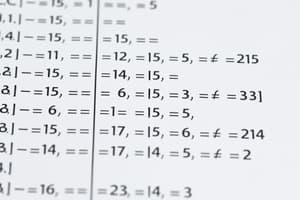Podcast
Questions and Answers
What type of variable is defined as one that can increase or decrease the strength of the relationship between the independent and dependent variables?
What type of variable is defined as one that can increase or decrease the strength of the relationship between the independent and dependent variables?
- Confounding variable
- Extraneous variable (correct)
- Intervening variable
- Control variable
Which variable serves as a link or connection between the independent and dependent variables in a study?
Which variable serves as a link or connection between the independent and dependent variables in a study?
- Extraneous variable
- Independent variable
- Intervening variable (correct)
- Dependent variable
What role does access to medical care play in the relationship between income and longevity?
What role does access to medical care play in the relationship between income and longevity?
- Moderating variable
- Intervening variable (correct)
- Control variable
- Extraneous variable
In the example of studying the effect of television watching on achievement, which of the following is considered an extraneous variable?
In the example of studying the effect of television watching on achievement, which of the following is considered an extraneous variable?
Which term refers to variables that are not measured in a study but still may affect the relationship being investigated?
Which term refers to variables that are not measured in a study but still may affect the relationship being investigated?
What is the primary role of an independent variable (IV) in a study?
What is the primary role of an independent variable (IV) in a study?
Which of the following best defines a dependent variable (DV)?
Which of the following best defines a dependent variable (DV)?
In the context of causal relationships, how would you identify an independent variable?
In the context of causal relationships, how would you identify an independent variable?
Which of the following examples represents a dependent variable?
Which of the following examples represents a dependent variable?
What is a characteristic of both independent and dependent variables in a study?
What is a characteristic of both independent and dependent variables in a study?
What characterizes a discrete quantitative variable?
What characterizes a discrete quantitative variable?
Which of the following is an example of a continuous variable?
Which of the following is an example of a continuous variable?
Which type of qualitative variable has two categories?
Which type of qualitative variable has two categories?
What characteristic is NOT present in nominal measurement scales?
What characteristic is NOT present in nominal measurement scales?
What type of measurement scale is most appropriate for ranking variables?
What type of measurement scale is most appropriate for ranking variables?
Which of the following variables is classified as a qualitative variable?
Which of the following variables is classified as a qualitative variable?
How do interval scales differ from ratio scales?
How do interval scales differ from ratio scales?
What type of analysis is possible with interval measurement scales?
What type of analysis is possible with interval measurement scales?
Which measurement scale provides information on the magnitude of differences in variable values?
Which measurement scale provides information on the magnitude of differences in variable values?
What characteristic is unique to the ratio scale compared to the other scales?
What characteristic is unique to the ratio scale compared to the other scales?
How does the ordinal scale differ from the nominal scale?
How does the ordinal scale differ from the nominal scale?
Which of the following variables is classified at the nominal level of measurement?
Which of the following variables is classified at the nominal level of measurement?
Which level of measurement allows for both ranking and absolute differences?
Which level of measurement allows for both ranking and absolute differences?
What can be concluded about the number of computers owned by a household in terms of measurement scale?
What can be concluded about the number of computers owned by a household in terms of measurement scale?
Which variable represents qualitative data?
Which variable represents qualitative data?
The grade point average on a scale from 0.0 to 4.0 is classified as which level of measurement?
The grade point average on a scale from 0.0 to 4.0 is classified as which level of measurement?
Which characteristic is true for interval scales but not for ratio scales?
Which characteristic is true for interval scales but not for ratio scales?
What does the zero point on the interval scale represent?
What does the zero point on the interval scale represent?
Which of the following is an example of data measured on a ratio scale?
Which of the following is an example of data measured on a ratio scale?
In which way do interval scales differ from ordinal scales?
In which way do interval scales differ from ordinal scales?
Why can ratios not be calculated with interval scale data?
Why can ratios not be calculated with interval scale data?
Which of the following would be categorized as interval data?
Which of the following would be categorized as interval data?
Which of the following is NOT a property of ratio scales?
Which of the following is NOT a property of ratio scales?
Which measurement scale would you generally use to report salary data?
Which measurement scale would you generally use to report salary data?
Flashcards are hidden until you start studying
Study Notes
Types of Variables
-
Variables are classified based on causal relationship, study design and unit of measurement
-
Independent variable (IV): Cause of change in a phenomenon
- Manipulated or controlled by a researcher
- Examples: Teaching method, medical treatment, training regimen
-
Dependent variable (DV): Outcome or effect of changes
- Result of IV manipulation
- Examples: Achievement is the result of a teaching method, cure is the result of a medical treatment, and skill level the result of training regimen
-
Extraneous variables: Other variables not measured in a study
- May affect the relationship between IV and DV
- Example: "Type of program" when studying the effect of "television watching" (IV) on "achievement" (DV)
-
Intervening (mediating) variable: Connects/links IV and DV
- Relationship between IV and DV might not be observed without the intervening variable
- Example: "Access to medical care" when studying the association between "income" and "longevity"
Unit of Measurement
-
Quantitative Variables: Values represent quantities, can be discrete or continuous
- Discrete: Numerical values from counting (e.g., Household size, number of accidents)
- Continuous: Numerical values from measuring (e.g., age, income, distance)
-
Qualitative (Categorical) Variables: Can be placed into categories
- Dichotomous: Two categories (e.g., yes/no, male/female)
- Polytomous: More than two categories (e.g., Marital status: single, married, divorced, widowed)
Measurement Scales
-
Nominal Scale: Classifies objects into groups
- Classification: Yes
- Order: No
- Distance: No
- Origin: No
-
Ordinal Scale: Ranks order of categories in a nominal scale
- Classification: Yes
- Order: Yes
- Distance: No
- Origin: No
-
Interval Scale: Provides information about the magnitude of differences between values
- Classification: Yes
- Order: Yes
- Distance: Yes
- Origin: No
- Examples: Centigrade/Fahrenheit temperature scales, Attitude scales
-
Ratio Scale: Indicates ratio of values
- Classification: Yes
- Order: Yes
- Distance: Yes
- Origin: Yes
- Examples: Salary, profit, age, concentration, drug dose, etc.
Summary of Measurement Scales
- Nominal scale provides basic classification.
- Ordinal scale adds rank-ordering.
- Interval scale measures the magnitude of differences.
- Ratio scale indicates proportions.
Ratio is the highest level of measurement
- All mathematical operations can be used on ratio scale data.
- Ratio scale has an absolute zero point, meaning there is no value below zero.
- Lower level measurement scales can be converted to higher levels.
Data Measurement Levels
- Qualitative data uses nominal or ordinal scales.
- Quantitative data uses interval or ratio scales.
Studying That Suits You
Use AI to generate personalized quizzes and flashcards to suit your learning preferences.




